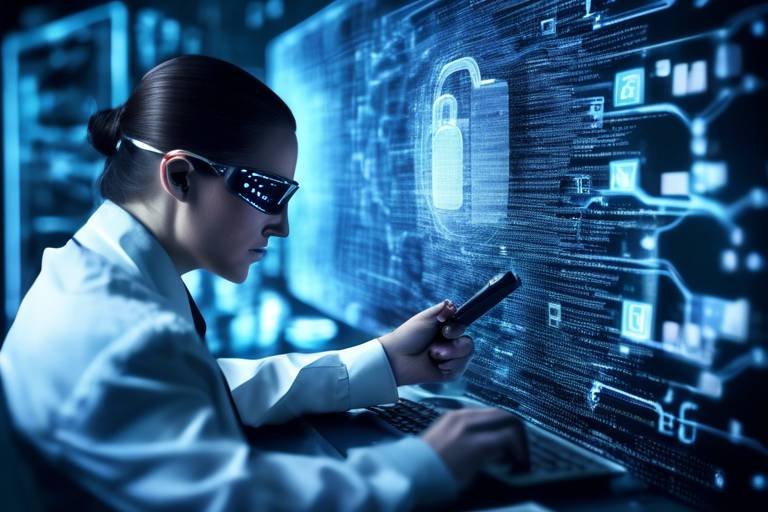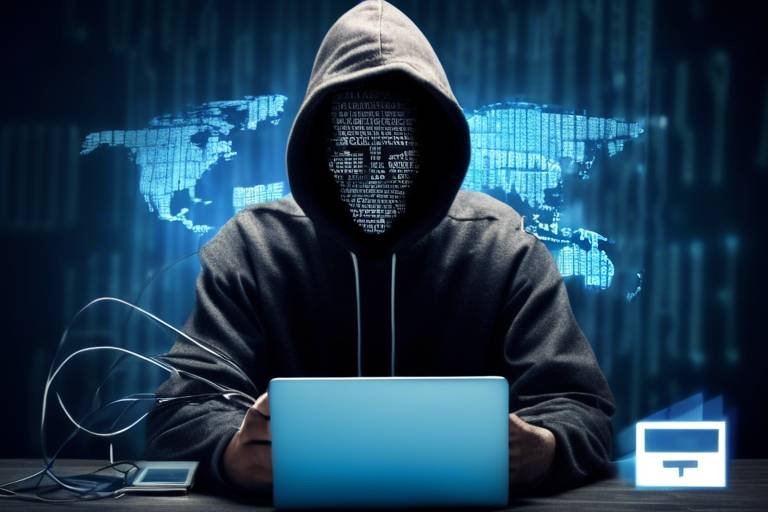The Role of Cyber Forensics in Cybersecurity
In today's digital age, where every click and keystroke can leave a trace, the role of cyber forensics has never been more crucial. As we dive deeper into the realms of cybersecurity, understanding how cyber forensics enhances our protective measures against cybercrimes becomes essential. Think of cyber forensics as the detective work of the digital world—it's all about gathering evidence, piecing together clues, and solving the mysteries behind cyber incidents. Just as a detective examines a crime scene, cyber forensic experts sift through data, uncovering hidden information that can reveal the motives and methods of cybercriminals.
Cyber forensics is not just about finding who did it; it’s about understanding how they did it and preventing future occurrences. This intricate process involves the collection, preservation, and analysis of digital evidence, which can range from emails and documents to network traffic and system logs. The methodologies employed in cyber forensics are designed to ensure that the evidence collected is both reliable and admissible in a court of law. This is particularly important as the legal landscape surrounding cybercrime continues to evolve, making it imperative for forensic investigations to adhere to strict standards.
Moreover, the importance of cyber forensics extends beyond just solving crimes. It plays a vital role in enhancing overall cybersecurity measures. By identifying vulnerabilities within systems and networks, organizations can proactively mitigate threats before they escalate into full-blown attacks. In essence, cyber forensics acts as a safety net, ensuring that businesses not only respond to incidents but also learn from them to bolster their defenses. As we explore the various techniques and challenges associated with cyber forensics in the upcoming sections, it becomes clear that this discipline is not just a reactive measure but a fundamental component of a robust cybersecurity strategy.
As we navigate through the complexities of the digital landscape, the integration of cyber forensics into cybersecurity practices is akin to having a well-trained guard dog protecting your home. It’s not just about barking at intruders; it’s about understanding their behavior, predicting their moves, and taking steps to secure the premises. By harnessing the power of cyber forensics, organizations can not only protect their digital assets but also foster a culture of security awareness and resilience. So, let’s delve deeper into the world of cyber forensics and uncover the techniques, challenges, and future trends that are shaping this dynamic field.
- What is cyber forensics? Cyber forensics involves the collection, preservation, and analysis of digital evidence to investigate cybercrimes.
- Why is cyber forensics important in cybersecurity? It helps identify vulnerabilities, mitigate threats, and ensure compliance with legal regulations, thereby strengthening cybersecurity strategies.
- What techniques are used in cyber forensics? Techniques include data recovery, network forensics, and malware analysis, each serving specific roles in investigations.
- What are the challenges faced in cyber forensics? Rapid technological advancements and legal complexities present significant hurdles for forensic investigations.
- What future trends are emerging in cyber forensics? Trends include the integration of AI and machine learning, as well as the development of cloud forensics.

Understanding Cyber Forensics
Cyber forensics is a critical field that revolves around the meticulous collection, preservation, and analysis of digital evidence. Imagine it as a digital detective work, where experts sift through the vast amounts of data generated by our modern technology to uncover the truth behind cybercrimes. Just like how a detective examines a crime scene for clues, cyber forensics professionals delve into digital environments to find evidence of malicious activities. This process is not just about finding what was lost; it’s about piecing together a narrative that can lead to justice.
The principles of cyber forensics are rooted in a systematic approach that ensures the integrity of evidence. For instance, every action taken during an investigation must be documented meticulously. This is crucial because, in the world of digital evidence, even the slightest alteration can render the evidence inadmissible in a court of law. Think of it like maintaining a chain of custody for a physical piece of evidence; if that chain is broken, the evidence can lose its credibility.
In terms of methodologies, cyber forensics employs a variety of techniques and tools, each tailored to specific scenarios. These methodologies can be broadly categorized into several key areas, including:
- Data Acquisition: This involves the initial collection of data from various sources such as computers, servers, and mobile devices.
- Data Analysis: Here, forensic experts analyze the collected data to identify patterns, anomalies, and relevant information.
- Reporting: After analysis, findings are compiled into a comprehensive report that can be presented in legal proceedings.
Moreover, cyber forensics is not limited to just investigating crimes. It also plays a vital role in incident response and prevention. By understanding how cyberattacks occur, organizations can implement stronger security measures to protect their digital assets. It’s like learning from past mistakes; by analyzing previous breaches, companies can fortify their defenses against future threats.
In essence, the world of cyber forensics is constantly evolving, driven by the rapid pace of technological advancements. As cybercriminals become more sophisticated, so too must the methods used by forensic investigators. This ongoing battle between good and evil in the digital realm highlights the importance of staying updated with the latest tools and techniques in cyber forensics.
Ultimately, understanding cyber forensics is essential for anyone involved in cybersecurity. It’s not just about reacting to incidents; it’s about proactively safeguarding digital environments and ensuring that when cybercrimes do occur, there are trained professionals ready to uncover the truth and bring perpetrators to justice.
What is cyber forensics?
Cyber forensics refers to the process of collecting, preserving, and analyzing digital evidence to investigate cybercrimes and security incidents.
Why is cyber forensics important?
It plays a crucial role in identifying vulnerabilities, mitigating threats, and ensuring compliance with legal regulations, thereby strengthening overall cybersecurity strategies.
What techniques are used in cyber forensics?
Common techniques include data recovery, network forensics, malware analysis, and digital evidence analysis.
What are the challenges in cyber forensics?
Challenges include rapid technological advancements, legal complexities, and the ever-evolving tactics of cybercriminals.
What is the future of cyber forensics?
The future may see increased integration of AI and machine learning, as well as the development of cloud forensics due to the rise of cloud computing.

Importance of Cyber Forensics in Cybersecurity
In today's digital landscape, where businesses and individuals are increasingly reliant on technology, the importance of cyber forensics cannot be overstated. Cyber forensics acts as a critical backbone of cybersecurity, providing the necessary tools and methodologies to investigate and mitigate cyber threats. Imagine a detective piecing together clues from a crime scene; that's exactly what cyber forensics does in the digital world. It helps organizations unearth vulnerabilities, understand breaches, and ultimately fortify their defenses against future attacks.
One of the primary roles of cyber forensics is to identify vulnerabilities within an organization’s network. By analyzing digital evidence, forensic experts can pinpoint weaknesses that may have been exploited by attackers. This identification process is crucial because it allows organizations to patch these vulnerabilities before they can be targeted again. In essence, cyber forensics acts like a security audit, revealing areas that need improvement and ensuring that cybersecurity measures are robust and up-to-date.
Moreover, cyber forensics plays a pivotal role in the mitigation of threats. When a cyber incident occurs, the speed at which an organization can respond is vital. Forensic investigations can help in quickly assessing the situation, understanding the scope of the breach, and implementing immediate countermeasures. This rapid response can significantly reduce the potential damage caused by cybercriminals. Think of it as having a fire extinguisher ready when a fire breaks out; the quicker you act, the less damage there will be.
Another critical aspect is compliance with legal regulations. Many industries are bound by strict regulations regarding data protection and privacy. Cyber forensics ensures that organizations adhere to these regulations by providing a framework for handling and investigating data breaches. In situations where legal action may be necessary, having a well-documented forensic investigation can serve as invaluable evidence in court. This not only protects the organization but also builds trust with clients and stakeholders, who are increasingly concerned about how their data is handled.
Furthermore, the insights gained from cyber forensic investigations can help organizations develop stronger cybersecurity strategies. After analyzing incidents, organizations can implement new policies and training programs to educate employees about potential threats. This proactive approach fosters a culture of security awareness, where everyone in the organization understands their role in protecting digital assets.
To summarize, the importance of cyber forensics in cybersecurity can be encapsulated in the following key points:
- Identifying Vulnerabilities: Pinpointing weaknesses in the system to prevent future attacks.
- Mitigating Threats: Quick response to incidents to minimize damage.
- Ensuring Compliance: Adhering to legal regulations and protecting the organization’s reputation.
- Enhancing Cybersecurity Strategies: Using insights from investigations to build a more robust security posture.
In conclusion, cyber forensics is not just an afterthought; it is a fundamental component of a comprehensive cybersecurity strategy. By investing in cyber forensics, organizations can better protect themselves against the ever-evolving landscape of cyber threats, ensuring their digital assets remain secure.

Techniques Used in Cyber Forensics
When it comes to cyber forensics, the techniques employed are as varied as the cybercrimes themselves. Each method plays a crucial role in uncovering the truth hidden within the digital chaos. Imagine a detective piecing together a puzzle; every piece of evidence collected can lead to a breakthrough in understanding what really happened during a cyber incident. Here, we’ll delve into some of the most commonly used techniques in cyber forensics, highlighting their significance and applications.
One of the primary techniques in cyber forensics is data recovery. This process is essential, especially when dealing with cases involving deleted files or corrupted data. Investigators use specialized tools that can retrieve lost information from hard drives, USB drives, or any digital storage device. For instance, when a company experiences a data breach, recovering sensitive customer information can be crucial for mitigating damage and understanding the breach's scope. The tools utilized in data recovery can include software like Recuva or Stellar Data Recovery, which are designed to restore files that may seem permanently lost.
Another significant technique is network forensics. This involves monitoring and analyzing network traffic to detect any unauthorized access or malicious activities. Think of it as a security camera for your digital environment. By examining data packets that traverse the network, forensic experts can identify unusual patterns, pinpoint the source of a breach, and even trace the actions of cybercriminals. Network forensics is particularly vital for organizations that rely heavily on online transactions, as it helps ensure that their data remains secure and that they can respond swiftly to any threats.
Additionally, malware analysis is a critical technique in the cyber forensics toolkit. Cybercriminals often deploy malicious software to execute their attacks, and understanding how this malware operates is key to preventing future incidents. By dissecting malware, forensic analysts can determine its origin, functionality, and potential impact. This process not only aids in mitigating the current threat but also enhances an organization’s overall cybersecurity posture. Tools like IDA Pro and Wireshark are commonly used for this purpose, allowing analysts to reverse-engineer malware and develop countermeasures.
In summary, the techniques used in cyber forensics are integral to the field of cybersecurity. They not only help in the investigation of cybercrimes but also play a preventive role in safeguarding digital assets. With the landscape of cyber threats constantly evolving, the importance of these techniques cannot be overstated. As we continue to advance technologically, the methodologies of cyber forensics will undoubtedly adapt and improve, ensuring that we remain one step ahead of cybercriminals.
- What is the primary goal of cyber forensics? The main goal is to collect, preserve, and analyze digital evidence to investigate cybercrimes effectively.
- How does data recovery work in cyber forensics? Data recovery involves using specialized software to retrieve lost or deleted files from digital storage devices.
- Why is network forensics important? It helps in monitoring network traffic to detect unauthorized access and malicious activities, ensuring the security of digital assets.
- What tools are commonly used in malware analysis? Tools like IDA Pro and Wireshark are frequently employed to dissect and understand malware.

Data Recovery Methods
Data recovery is a cornerstone of cyber forensics, serving as a crucial lifeline when investigators are faced with lost or deleted digital evidence. Imagine a detective sifting through a crime scene, only to discover that key evidence has been erased. This is where data recovery techniques come into play, allowing forensic experts to retrieve vital information that could lead to solving a cybercrime. The methods employed in data recovery can vary significantly based on the type of data loss, whether it's due to accidental deletion, hardware failure, or even malicious attacks.
One of the most widely used methods is file carving, which involves scanning a storage medium for file signatures and reconstructing files without relying on the file system. This technique is particularly effective when the file system is corrupted or has been formatted. Think of it as piecing together a jigsaw puzzle where the box lid is missing; you have to rely on the shapes and colors to find the right fit. Furthermore, tools like EnCase and FTK Imager are invaluable in this process, providing forensic investigators with the means to recover files efficiently.
Another significant method is disk imaging, which involves creating an exact copy of a storage device. This is crucial because it allows forensic analysts to work on a duplicate of the original data, preserving the integrity of the evidence. By using tools such as dd or Clonezilla, investigators can create a bit-by-bit image of the drive, ensuring that no data is altered during the recovery process. This is akin to having a backup plan in case things go awry; it ensures that you have the original data untouched and available for further analysis.
Moreover, logical recovery techniques are employed when the file system is intact but files have been deleted. This method utilizes the operating system's structures to locate and recover lost files. Here, software like Recuva or R-Studio comes into play, scanning the file system for recoverable data. It's like searching for a needle in a haystack, but with the right tools, that needle can often be found.
In addition to these methods, forensic investigators also face the challenge of dealing with encrypted data. In such cases, specialized tools and techniques are required to bypass encryption and retrieve the necessary evidence. This is where the skills of a forensic expert truly shine, as they must navigate through complex security measures to access crucial information.
As technology continues to evolve, so do the methods of data recovery. Newer approaches, such as cloud data recovery, are emerging, which focus on retrieving data from cloud storage solutions. This is particularly relevant in today's world, where many organizations rely on cloud services for their data management. The need for cyber forensics experts to stay ahead of these trends is more critical than ever.
In conclusion, data recovery methods in cyber forensics are not just technical processes; they are vital components in the broader landscape of cybersecurity. By employing a combination of techniques, forensic experts can ensure that even the most elusive data can be recovered, ultimately aiding in the fight against cybercrime.
- What is data recovery in cyber forensics? Data recovery in cyber forensics refers to the process of retrieving lost, deleted, or corrupted data to investigate cybercrimes.
- What tools are commonly used for data recovery? Tools such as EnCase, FTK Imager, Recuva, and R-Studio are widely used in the field of data recovery.
- How does disk imaging work? Disk imaging involves creating an exact copy of a storage device, allowing forensic analysts to work on a duplicate while preserving the original data.
- Can encrypted data be recovered? Yes, specialized tools and techniques can be used to recover encrypted data, although it can be more complex than recovering unencrypted data.

Network Forensics
Network forensics is a crucial aspect of cyber forensics that focuses on monitoring and analyzing network traffic to detect and respond to malicious activities. Imagine trying to catch a thief in a crowded marketplace; you need to pay close attention to the flow of people, their actions, and any suspicious behavior. Similarly, network forensics involves scrutinizing data packets as they traverse through networks, allowing investigators to identify security breaches and understand how they occurred.
One of the primary goals of network forensics is to reconstruct events surrounding a cyber incident. This means capturing and analyzing data in real-time, which can be incredibly challenging due to the sheer volume of information that flows through networks every second. To tackle this, network forensic analysts utilize a variety of tools and techniques, including packet sniffers, intrusion detection systems (IDS), and security information and event management (SIEM) solutions. These tools help provide a comprehensive view of the network's activity, enabling analysts to pinpoint anomalies that could indicate a security threat.
Furthermore, network forensics plays a vital role in incident response. When an organization experiences a security breach, the first step is to contain the threat. However, understanding the extent of the breach requires a thorough investigation of the network traffic leading up to the incident. By analyzing this data, forensic experts can determine how the attack was executed, what vulnerabilities were exploited, and what data may have been compromised. This information is not only essential for mitigating the current threat but also for preventing future incidents.
In addition to real-time monitoring, network forensics also involves the collection and preservation of data for legal proceedings. In many cases, cybercriminals leave behind a digital trail that can be used to trace their activities. This trail may include IP addresses, timestamps, and specific actions taken on the network. Forensic experts must ensure that this evidence is collected in a manner that maintains its integrity, making it admissible in court if necessary.
As cyber threats continue to evolve, so does the field of network forensics. New technologies, such as artificial intelligence and machine learning, are being integrated into forensic practices to enhance threat detection and data analysis capabilities. For instance, AI can analyze vast amounts of network traffic much faster than a human, identifying patterns and anomalies that might otherwise go unnoticed. This not only improves the efficiency of forensic investigations but also strengthens an organization's overall cybersecurity posture.
In conclusion, network forensics is an indispensable tool in the cybersecurity arsenal. By meticulously analyzing network traffic, forensic experts can uncover the truth behind cyber incidents, helping organizations to respond effectively and bolster their defenses against future attacks. As technology continues to advance, the techniques and tools used in network forensics will undoubtedly evolve, paving the way for more robust cybersecurity strategies in the digital age.

Challenges in Cyber Forensics
In the rapidly evolving world of technology, cyber forensics faces a myriad of challenges that can hinder effective investigations. One of the most significant hurdles is the pace of technological advancement. As new technologies emerge, so do new methods of committing cybercrimes, making it increasingly difficult for forensic experts to keep up. Just think about it: every time a new software is released or an update is made, the potential for exploitation increases, and so does the complexity of tracing digital footprints.
Another major challenge is the legal complexities surrounding digital evidence. The laws governing cyber forensics vary significantly across different jurisdictions, and navigating these legal waters can be daunting. For instance, what is permissible in one country might be illegal in another, creating a patchwork of regulations that forensic investigators must understand thoroughly. This legal ambiguity can lead to complications in presenting evidence in court, potentially jeopardizing cases.
Moreover, the sheer volume of data generated every second poses a significant challenge for cyber forensics. With the rise of the Internet of Things (IoT), the amount of data available for analysis has exploded. Investigators often find themselves overwhelmed with information, making it difficult to pinpoint relevant data. To illustrate, imagine trying to find a needle in a haystack, where the haystack keeps growing while you're searching!
Another critical issue is the encryption of data. While encryption is vital for protecting sensitive information, it also complicates forensic investigations. Cybercriminals often use sophisticated encryption techniques to hide their activities, making it challenging for forensic experts to access the necessary data. This cat-and-mouse game between cybercriminals and forensic investigators can be frustrating, as each party continuously adapts to outsmart the other.
Lastly, the lack of standardized practices in cyber forensics can lead to inconsistencies in investigations. Different organizations may employ varying methodologies, which can result in discrepancies and confusion when collaborating on cases. To combat this, there is a growing call for the establishment of universal standards and best practices that all forensic investigators can adhere to. This would not only streamline investigations but also enhance the credibility of the findings.
In summary, while cyber forensics plays a crucial role in combating cybercrime, it is not without its challenges. From keeping pace with technology to navigating legal complexities and managing vast amounts of data, forensic experts face an uphill battle. However, by addressing these challenges head-on, the field can continue to evolve and improve, ensuring that justice prevails in the digital world.
- What is cyber forensics? Cyber forensics refers to the process of collecting, preserving, and analyzing digital evidence to investigate cybercrimes.
- Why is cyber forensics important in cybersecurity? It helps identify vulnerabilities, mitigate threats, and ensure compliance with legal regulations, thereby strengthening overall cybersecurity strategies.
- What are some common challenges in cyber forensics? Common challenges include rapid technological advancements, legal complexities, data volume, encryption, and lack of standardized practices.
- How can AI improve cyber forensics? AI can enhance data analysis and threat detection capabilities, making investigations more efficient and effective.

Future Trends in Cyber Forensics
The future of cyber forensics is not just an extension of current practices; it's a revolution fueled by rapid technological advancements. As we dive deeper into the digital age, the landscape of cyber forensics is evolving, and several trends are emerging that will significantly shape its trajectory. One of the most exciting developments is the integration of Artificial Intelligence (AI) and Machine Learning. These technologies are enhancing the ability to analyze vast amounts of data quickly and identify potential threats more effectively than ever before.
Imagine a world where cyber forensics can predict cybercrimes before they happen, much like how meteorologists forecast weather patterns. AI algorithms can sift through enormous datasets, learning from past incidents to detect anomalies that could indicate a breach. This proactive approach not only saves time but also allows organizations to fortify their defenses before an attack occurs.
Another significant trend is the rise of cloud forensics. As more businesses migrate to cloud environments, understanding how to conduct forensic investigations in these spaces becomes crucial. Traditional forensics techniques may not be sufficient due to the unique challenges posed by cloud architectures. For instance, data is often distributed across multiple servers, making it challenging to trace and analyze. Cyber forensics experts are now developing cloud-specific methodologies to address these challenges, ensuring that digital evidence remains intact and accessible even in complex cloud ecosystems.
Furthermore, the legal landscape surrounding cyber forensics is also evolving. With increasing regulations around data privacy and security, forensic investigators must stay abreast of legal standards and compliance requirements. This trend emphasizes the importance of integrating legal knowledge into forensic practices, ensuring that investigations are not only thorough but also adhere to the law.
In addition, the growing use of the Internet of Things (IoT) devices presents new challenges and opportunities for cyber forensics. As more devices connect to the internet, the potential for cyber threats expands exponentially. Forensics experts are now focusing on developing techniques to collect and analyze data from these devices, which often operate in unique environments and may not have traditional security measures in place. This shift requires a blend of technical skills and innovative thinking, as the forensic community adapts to the complexities of IoT.
Finally, the importance of collaboration among different stakeholders cannot be overstated. Cyber forensics will increasingly involve partnerships between private organizations, law enforcement, and government agencies. By sharing information and resources, these entities can create a more robust defense against cyber threats, leading to quicker response times and more effective investigations.
In summary, the future of cyber forensics is bright and filled with potential. With advancements in AI, cloud forensics, legal compliance, IoT, and collaborative efforts, the field is set to become more dynamic and effective in combating cybercrimes. As we embrace these trends, the ultimate goal remains the same: to protect digital assets and ensure a safer online environment for everyone.
- What is cyber forensics? Cyber forensics is the process of collecting, preserving, and analyzing digital evidence to investigate cybercrimes.
- How does AI enhance cyber forensics? AI improves data analysis and threat detection capabilities, allowing for quicker identification of potential cyber threats.
- What challenges does cloud forensics face? Cloud forensics must address issues like data distribution across servers and maintaining the integrity of digital evidence.
- Why is collaboration important in cyber forensics? Collaboration among various stakeholders leads to improved information sharing, quicker response times, and more effective investigations.

AI and Machine Learning in Cyber Forensics
In today's fast-paced digital landscape, the integration of Artificial Intelligence (AI) and Machine Learning (ML) into cyber forensics is not just a trend; it's a necessity. As cyber threats become increasingly sophisticated, traditional forensic methods struggle to keep pace. This is where AI and ML step in, offering a powerful arsenal to combat cybercrime. These technologies enable forensic investigators to analyze vast amounts of data quickly and accurately, identifying patterns and anomalies that may indicate malicious activities.
Imagine trying to find a needle in a haystack—the haystack being the enormous volume of digital data generated every minute. AI and ML algorithms act like a magnet, drawing out the relevant data points and presenting them in a comprehensible manner. They can sift through logs, emails, and files, learning from previous incidents to enhance their detection capabilities. This not only speeds up investigations but also improves their accuracy, reducing the chances of human error.
Moreover, AI can assist in predictive analysis, which involves anticipating future threats based on historical data. By analyzing trends and behaviors, these systems can flag potential vulnerabilities before they are exploited. For instance, if a certain type of phishing attack has been rising in frequency, an AI system can alert cybersecurity teams to bolster defenses in that area. This proactive approach is a game-changer in the world of cyber forensics.
However, the adoption of AI and ML in cyber forensics isn't without its challenges. For one, there is a significant need for high-quality data to train these algorithms effectively. If the data fed into the system is biased or incomplete, the outcomes can be misleading. Additionally, as these technologies evolve, so do the tactics employed by cybercriminals. This creates a perpetual game of cat and mouse, where forensic teams must continuously adapt their strategies to stay one step ahead.
To illustrate the impact of AI and ML in cyber forensics, consider the following table that highlights some of the key applications:
| Application | Description |
|---|---|
| Data Classification | AI algorithms can categorize data into various types, making it easier to identify relevant information during investigations. |
| Anomaly Detection | Machine learning models can identify unusual patterns in network traffic, flagging potential security breaches. |
| Incident Response | AI can automate responses to certain types of incidents, reducing the time it takes to mitigate threats. |
| Threat Intelligence | AI systems can analyze threat data in real-time, providing insights that help organizations stay ahead of emerging threats. |
As we look toward the future, the role of AI and ML in cyber forensics will only grow. Organizations that invest in these technologies will not only enhance their forensic capabilities but also strengthen their overall cybersecurity posture. It's an exciting time in the field, and the potential for innovation is limitless.
- What is the primary benefit of using AI in cyber forensics? AI helps in quickly analyzing large datasets, identifying patterns, and improving the speed and accuracy of investigations.
- Can AI completely replace human investigators? While AI can significantly enhance forensic investigations, human oversight is still crucial for interpreting results and making informed decisions.
- What challenges do AI and ML face in cyber forensics? Challenges include the need for high-quality training data, the evolving tactics of cybercriminals, and the potential for biased outcomes if the data is not representative.

Cloud Forensics
In today's digital landscape, where data is increasingly stored in the cloud, has emerged as a crucial field within cybersecurity. Imagine a world where your vital information floats in the vast expanse of cyberspace, accessible from anywhere but also vulnerable to various threats. Cloud forensics is the practice of collecting, preserving, and analyzing data from cloud environments, making it essential for investigating cybercrimes that target these platforms.
One of the primary challenges in cloud forensics is the shared responsibility model that governs cloud security. This model delineates the responsibilities of cloud service providers (CSPs) and their clients, often leading to confusion regarding who is accountable for data breaches. For instance, while a CSP may ensure the physical security of their servers, the client is typically responsible for securing their data and applications. This division can complicate forensic investigations as both parties must collaborate to gather relevant evidence.
Moreover, the ephemeral nature of cloud data presents another hurdle. Data stored in the cloud can be deleted or altered at any moment, making it imperative for forensic experts to act swiftly. The use of virtual machines and containers in cloud environments adds layers of complexity, as investigators need to understand how these technologies operate to effectively retrieve and analyze evidence. In many cases, the data involved may not reside on a single server but instead be distributed across multiple locations, complicating the forensic process further.
To tackle these challenges, forensic investigators employ a variety of techniques tailored to cloud environments. These methods include:
- Data Acquisition: Collecting data from cloud storage, which may involve using APIs or direct access to cloud services.
- Log Analysis: Examining logs generated by cloud services to trace user activity and identify potential security breaches.
- Container Forensics: Analyzing container images and their configurations to uncover any malicious activities.
As cloud adoption continues to grow, organizations must prioritize cloud forensics in their cybersecurity strategies. By doing so, they not only enhance their ability to respond to incidents but also strengthen their overall security posture. The future of cloud forensics is bright, with advancements in technology and methodologies paving the way for more effective investigations.
In conclusion, cloud forensics is not just a technical necessity; it's a vital component of modern cybersecurity. As we navigate this digital age, understanding and implementing robust cloud forensic practices will be paramount in safeguarding our data and ensuring accountability in the cloud.
- What is cloud forensics? Cloud forensics is the process of collecting, preserving, and analyzing data from cloud environments to investigate cybercrimes.
- Why is cloud forensics important? It is crucial for identifying and mitigating security breaches in cloud environments, ensuring accountability, and preserving digital evidence for legal proceedings.
- What are the challenges of cloud forensics? Challenges include the shared responsibility model, the ephemeral nature of cloud data, and the complexity of virtual machines and containers.
- How do investigators gather evidence in cloud forensics? Investigators use techniques such as data acquisition, log analysis, and container forensics to gather and analyze evidence.
Frequently Asked Questions
- What is cyber forensics?
Cyber forensics refers to the process of collecting, preserving, and analyzing digital evidence to investigate cybercrimes. It encompasses various methodologies and principles that help in uncovering the truth behind digital incidents, much like a detective solving a mystery.
- Why is cyber forensics important in cybersecurity?
Cyber forensics plays a critical role in enhancing cybersecurity by identifying vulnerabilities, mitigating threats, and ensuring compliance with legal regulations. It acts as a safety net, providing organizations with the insights they need to strengthen their overall security measures and protect their digital assets.
- What techniques are commonly used in cyber forensics?
Some of the most common techniques in cyber forensics include data recovery, network forensics, and malware analysis. Each of these methods serves a specific purpose, from retrieving lost data to monitoring network traffic for suspicious activities, ensuring a comprehensive approach to forensic investigations.
- What are the challenges faced in cyber forensics?
Cyber forensics faces several challenges, including rapid technological advancements that can outpace forensic methods, as well as legal complexities that may hinder investigations. These hurdles can complicate the process of gathering and analyzing evidence, making it essential for professionals to stay updated on the latest trends and regulations.
- How is AI integrated into cyber forensics?
The integration of AI and machine learning in cyber forensics is revolutionizing the field. These technologies enhance data analysis and threat detection capabilities, allowing forensic experts to process vast amounts of information quickly and accurately, much like having a supercharged assistant by their side.
- What is cloud forensics?
Cloud forensics involves the techniques and challenges associated with conducting forensic investigations in cloud computing environments. As more data is stored in the cloud, understanding how to effectively investigate incidents in this space is becoming increasingly important for cybersecurity professionals.



















